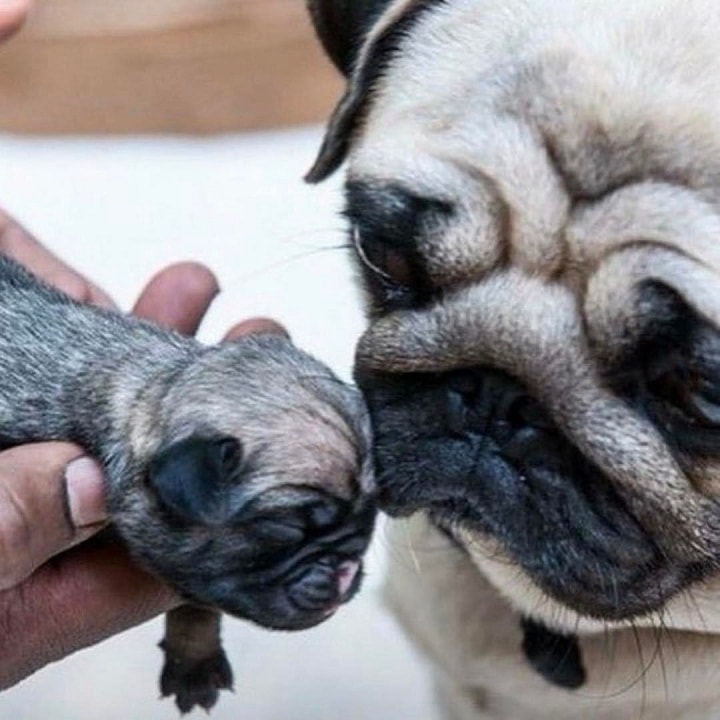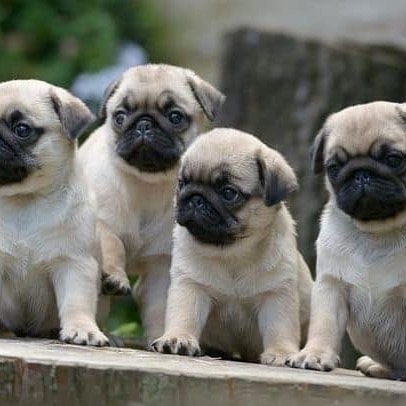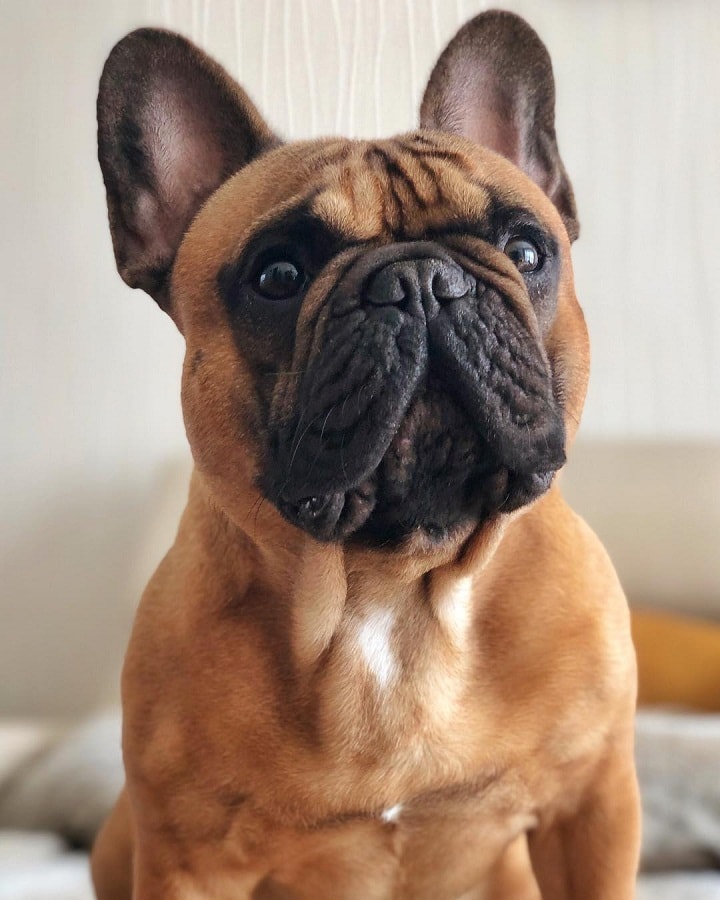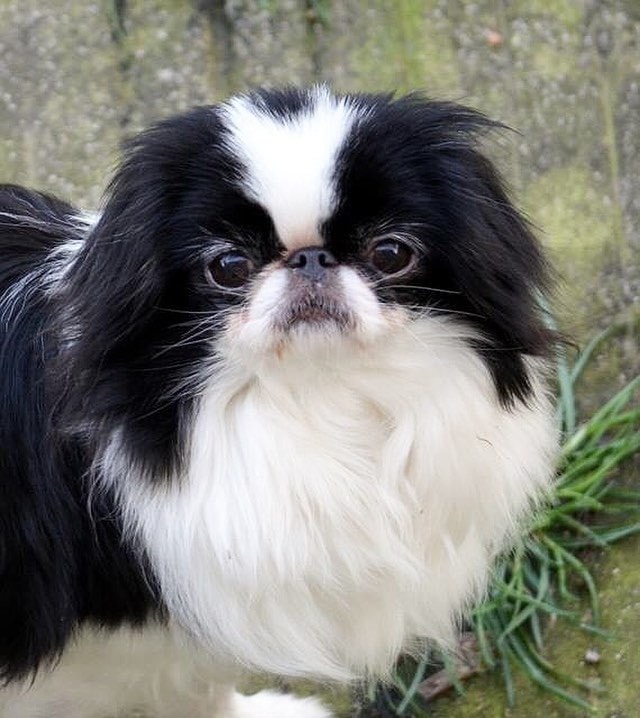Pug Dog Breed Information
| Country of Origin | China |
| Nicknames and Other Names | chinese pug Dutch mastiff |
| Scientific Name | Canis lupus familiaris |
| Breed Type | Purebred |
| Group | Companion Dogs Toy Group |
| Bred For | Companion dog |
| Size | Small-sized |
| Recognized By | AKC, UKC, ANKC, NZKC, CKC, KC, FCI |
| Life Span | 13-15 years |
| Ideal Weight | 14-18 pounds (male and female) |
| Ideal Height | 10-13 inches (male and female) |
| Fur Type | Short, smooth, glossy |
| Common Colors | Black Fawn |
| Markings | None |
| Availability | Widely available |
| Achievements | Official dog of the House of Orange Once used by the military |
| Suitable for Apartments | Very suitable |
| Used in World War | No |
| Most Similar To | French Bulldog |
Pug is a small-sized, distinctive looking dog with a curl-up tail. It is also known as a clown of the canine world. They have a great sense of humor and are always making people around them laugh with their silly acts.
Pugs owner says that they are an ideal pet for a family. Anyone who wants a dog that is funny, entertaining, and do not need to be exercised often, Pug is best. It is suitable in an apartment and they do not need big are to perform their silly acts.
The appearance of Pug is a square and cobby body. Their body is muscular with a wrinkled face and a deep chest. They are well known for their prominent eyes that are dark and round. The coat is short, smooth, glossy and neither hard nor woolly.
Origin and History
The Pug is an ancient dog breed that dates back more than 2000 years. It was originated in China and was a favorite of the Shang Dynasty rulers who used them as lap dogs. They were held as a tressure and outsiders will only acquire Pugs as a gift.
In the 15th century, the Dutch had imported the Pug to Europe. by the end of the 17th century, it gained popularity all over Europe.
The Pug was very popular with Queen Victoria and it was the involvement of Queen Victoria in Pug breeding, that led to the establishment of Kennel Club in 1873. The American Kennel Club registered Pug in 1885 as a member of the Toy Group.
Is Pug Child-Friendly?
The Pug is a very playful little dog that loves the company of children. It usually gets well with children of all ages. They are funny and entertaining due to which children will love them and they will make a great playmate with kids.
They might not tolerate children with rough and harsh behavior. Therefore, children should be taught to interact with the Pug and teach them how to behave around it.
Temperament, Behavior, and Personality
Temperament: The Pug has even temperament which is comical and loves their human companion. They want to be around people more than they want to be around their canine friends. It is a charming, fun-loving, and friendly nature dog who even welcome strangers warmly. Therefore, they should not be taken as a watch or
Behavior: The Pug has a clownish behavior as they are always doing some silly acts to make people laugh around them. They have a high tendency to make noise, therefore, they are frequently barking, snorting, grunting and so on. This noises will get loud if they are left alone for a long time without any human interaction.
Personality: The personality of the Pug is very charming and loving. They are not an aggressive dog and want to be by their people sides, either playing with them or sitting in their lap. They need a good amount of attention, so they only do best in the house where people are active and are not working outdoors.
Trainability
The Pug is an independent, smart, and stubborn dog that can be hard to train. They tend to get bored quickly with the repetitive task. Therefore, fun stuff should be included in the training, to keep them interested.
They are very eager to please their owner, so with gentleness, they could be easily trained. Pug responds well to treats, so delicious treats should be included as a reward. However, treats should be given in limited amount as they are quick to get fat.
Facts
- Queen Victoria had owned many Pug and she was a great fan of this dog. She also started breeding them and preferred apricot-fawn Pugs.
- The Pug was kept as a pet in Buddhist monasteries in Tibet.
- Napoleon’s wife Josephine used her Pug ‘Fortune’ to carry secret messages under his collar to her husband while she was imprisoned in Les Carmes.
- The perfect tail of a Pug has two curls.
Health Issues
| General Health | Healthy |
| Common Health Issues | Corneal Ulcer, Dry Eye, Entropion, Epilepsy, Demodectic Mange, Hemi-vertebrae |
| Hypoallergenic | No |
| Vaccination Required | Rabies, Leptospirosis, Canine Distemper, Canine Parvovirus, Canine Coronavirus Canine Parainfluenza, Kennel Cough |
| Shedding | Above Average Shedder |
| Drooling | Low Drooler |
| Grooming | Minimal Grooming Required |
| Weight Gain Potential | High Chance |
| Separation Anxiety | High Chance |
| Allergies | None |
| Diets and Supplements | Protein: 18% Fat: 5% Glucosamine Probiotics Antioxidant Fish Oil |
Pug is generally a healthy breed with a life span of 13-15 years. During this year, it can suffer from a few canine diseases, which are as follows:
- Obesity: The Pug is more likely to suffer from obesity as it loves to eat. Their eating habit should be controlled by giving a proper amount of food which contains a good amount of nutrition. They should be taken out for moderate exercise regularly to control them from getting fat and to remain healthy.
- Pug Dog Encephalitis: It is a fatal brain disease that causes the inflammation of the brain tissues. It is unique to Pug and it is still unknown what causes this health problem. The diagnosis of encephalitis can only be known after testing of the brain tissues. They will suffer from blindness, falls into a coma and dies in a few days or weeks.
Colors
The Pug comes in two of the following colors:
- Black
- Fawn
Puppies

Image Source: Instagram-@pugcute9 
Image Source: Instagram-@vip_dog_house
Cost: The average cost of the Pug puppy is between $1500-$2000 USD. However, adoption cost a lot less than buying from a breeder. The cost of the adoption is around $300 with the expenses of taking care of the puppy.
Height and Size: The average height of the Pug is 10-13 inches and the average weight is 14-18 pounds.
Similar Dog Breeds to The Pug Dog
Visit Doglime for more information about dog breeds history, behavior, training, and puppies.
Tags

















2 thoughts on “Pug Dog Breed Information”